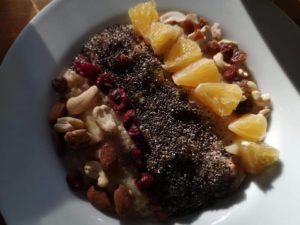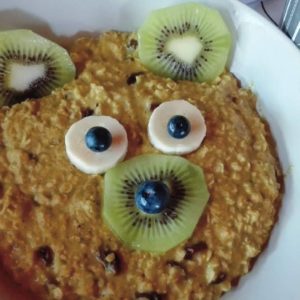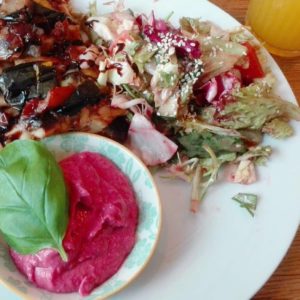Read this in: German
Every year at the beginning of the year the Veganuary invites you to deal with the vegan diet. Even though I’ve been vegan for a few years and mine has also been completely vegan for over a year, I learn something new every year and get new inspiration. Here are my five vegan basics.
Yeast Flakes
I personally love yeast flakes. However, I only discovered it for myself a few years ago. They are a good topping or binder for a cheese-like taste, as the taste itself is reminiscent of parmesan. Therefore, it is also suitable as a Parmesan substitute on pasta dishes. However, I can recommend that you avoid cooking yeast flakes if possible. Instead, it is best to stir them into a sauce at the end or sprinkle them over prepared foods. The conventional production process leads to the concentration of glutamic acids. That’s part of the taste. They are completely gluten-free and lactose-free and also low in sugar, fat and calories. Yeast flakes are extremely healthy because they are rich in vitamins B1, B2, B5 (pantothenic acid), B6 and folic acid. They also contain a lot of protein in the form of easily usable amino acids. Vitamin B5 helps the body to build up and break down carbohydrates and fats, and to metabolize cholesterol (source).
Or in less technical: they are simply good for enhancing a hearty meal with a little more umami taste. And in addition to the variety in the mouth, there is also a variety in the menu and thus a balanced yet varied diet. And yes, it is also possible without a meat substitute.

nuts
I have a lot of people around me who don’t eat nuts or who forbid themselves. And no, this is not about those who have a nut allergy. I cannot understand the reasons, because nuts are rich in fat and calories, but contain monounsaturated or polyunsaturated fatty acids. Depending on the variety, 100g contain between 45 and 70 grams of fat. In addition, nuts also contain protein, vitamins, trace elements and fiber. Because of their high magnesium and vitamin B content, they are good “food for the nerves”. The dietary fiber it contains stimulates digestion. Studies show that regular consumption of nuts lowers blood lipids, especially cholesterol, and thus also reduces the risk of heart attacks. Walnuts are rich in healthy omega-3 fatty acids, while almonds are said to have a positive effect on fat metabolism. Cashew nuts are relatively high in carbohydrates and hazelnuts are high in magnesium. So you can see that the different nuts have their respective advantages. A handful of nuts a day is healthy. It is important that they are without the addition of salt or spice mixtures (source: NDR).
And that’s why emergency nuts are just something that always belongs in my pocket. No matter where I am, if I’m stuck on the train 2 hours longer than planned, I have a small portion of nuts with me, which is incredibly filling and gives me the energy I need without having to buy anything at the train station when changing trains or have to carry huge lunch boxes with you. Such a small box of nuts fits in every handbag.

pumpkin
I love pumpkins, especially those from my parents’ garden. Unfortunately, the hot summers of the last three years have contributed to the fact that I had to buy pumpkins for the first time in my life, because the pumpkins in the garden at home have become nothing due to the heat and drought. Whether classics like pumpkin soup or pumpkin fries or in salads, pumpkin is very good. Our current favorite is pumpkin carbonara. Pumpkin is not only in season in autumn, it is still available in winter too. 100g of pulp contains only about 25 calories. The body also receives vitamins, potassium, calcium and zinc. In addition, the contained silica is good for connective tissue, skin and nails (source: NDR).
That’s why the pumpkin is wonderful to deal with – it goes both sweet and savory.

Chia seeds and flax seeds
Chia seeds are on my pore every morning as a topping. Porige, for me that is sometimes rice, sometimes millet and buckwheat and currently tiger nuts. On the subject of Porige, however, I would like to write in more detail in a few weeks. I also like to use flaxseed in a variety of ways in my kitchen. I particularly like to use them for my self-righteous oat-based chocolate bars with protein as a snack for before and after the workout. Chia seeds have many valuable ingredients. At the same time, they provide fiber and high-quality polyunsaturated fatty acids and contain more protein than cereals. They also supply the body with vitamins, minerals and secondary plant substances (source).
Flax seeds have a high fiber content (more than a third) and are therefore particularly good for digestion. The mucus and swelling substances, which are mainly found in the shell, ensure that you are full longer. They also contain almost 30 percent polyunsaturated omega 3 fatty acids. The proportion is even higher than with fish, which is considered to be the omega3 supplier. Flax seeds are rich in vitamins B1, B2, B6 and E and folic acid (source).
Therefore, for me, both are things that I cannot imagine my everyday life without – as a vegan you like to take seeds or kernels or nuts as a topping to get fat and protein and lots of macronutrients.

Psyllium husks and agartines
Auch Flohsamenschalen sind regelmäßig als To find topping on my smoothie bowls and porridge. They are also well suited as binders. They promote the health of the intestinal flora and support natural digestion. Fiber and mucilage, which are contained in particularly large quantities in psyllium husks, help here (Quelle). Agartine is also a great binding agent. We like to use them for cakes or other sweets. Agartine works in a similar way to gelatin. Argatine is a multiple sugar that occurs mainly in red algae. It is tasteless and well tolerated (Quelle).
Both are perfect for Dessert, pudding or psyllium husks are easy to use as a topping or in juice when the gastrointestinal area is dancing samba again.


















